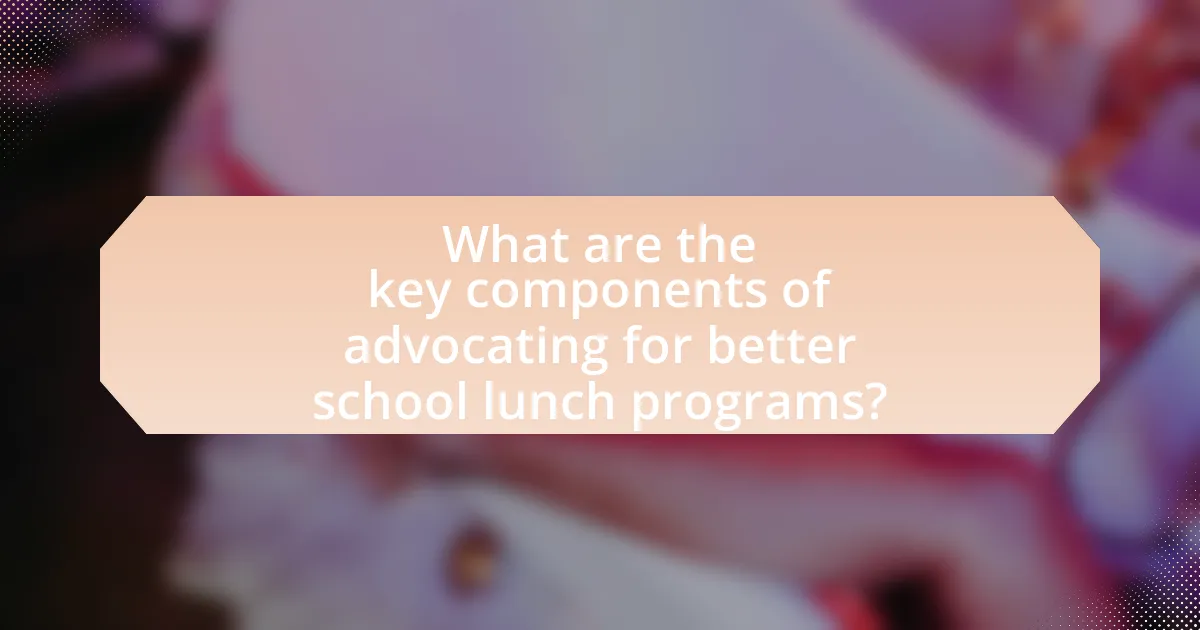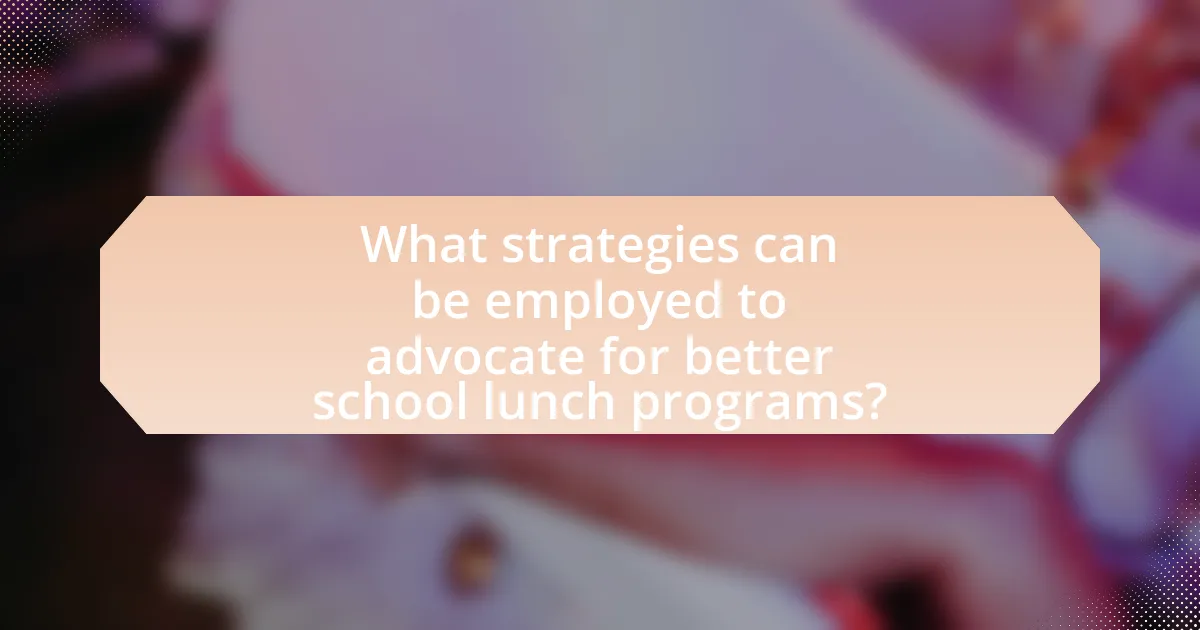The article focuses on advocating for better school lunch programs, highlighting key components such as raising awareness, building coalitions, engaging stakeholders, and promoting policy changes. It discusses the significant impact of school lunch programs on student health and learning, emphasizing the importance of meeting USDA nutritional standards. The article outlines strategies for effective advocacy, including community engagement, data-driven approaches, and leveraging partnerships with local organizations. Additionally, it addresses challenges faced by advocates, such as budget constraints and resistance from school administrations, while providing practical steps for individuals to get involved in improving school lunch initiatives.

What are the key components of advocating for better school lunch programs?
The key components of advocating for better school lunch programs include raising awareness, building coalitions, engaging stakeholders, and promoting policy changes. Raising awareness involves educating parents, students, and the community about the nutritional benefits of improved lunch programs, which can lead to better health outcomes. Building coalitions with local organizations, health professionals, and advocacy groups strengthens the movement and provides a unified voice. Engaging stakeholders, such as school administrators, teachers, and food service providers, ensures that the needs and perspectives of all parties are considered in the advocacy efforts. Promoting policy changes at the local, state, or federal level can lead to increased funding and support for healthier school meals, as evidenced by initiatives like the Healthy, Hunger-Free Kids Act of 2010, which aimed to improve the nutritional quality of school meals across the United States.
How do school lunch programs impact student health and learning?
School lunch programs significantly enhance student health and learning by providing nutritious meals that improve dietary intake and cognitive function. Research indicates that students who participate in these programs consume more fruits, vegetables, and whole grains, which are essential for physical health and academic performance. A study published in the Journal of School Health found that schools with robust lunch programs reported lower rates of obesity and improved academic outcomes, demonstrating a direct correlation between healthy eating and enhanced learning capabilities. Furthermore, access to balanced meals reduces absenteeism and behavioral issues, further supporting the notion that well-structured school lunch programs are vital for fostering both health and educational success among students.
What nutritional standards should school lunches meet?
School lunches should meet the nutritional standards set by the USDA, which include specific requirements for calories, sodium, saturated fat, and whole grains. These standards mandate that lunches provide a balanced meal with appropriate portions of fruits, vegetables, proteins, and grains, ensuring that students receive essential nutrients for their growth and development. For instance, the USDA guidelines specify that school lunches must include at least half a cup of fruits and vegetables, and at least one serving of whole grains each week. These regulations are designed to combat childhood obesity and promote healthier eating habits among students.
How does access to healthy food influence academic performance?
Access to healthy food significantly enhances academic performance by improving students’ cognitive function and concentration. Research indicates that students who consume nutritious meals exhibit better memory, attention, and problem-solving skills, which are crucial for learning. A study published in the Journal of School Health found that students with access to healthy food options scored higher on standardized tests compared to those with limited access to nutritious meals. This correlation suggests that proper nutrition directly impacts educational outcomes, emphasizing the importance of advocating for better school lunch programs to ensure all students have access to healthy food.
Why is advocacy important for school lunch programs?
Advocacy is important for school lunch programs because it drives policy changes that ensure access to nutritious meals for students. Effective advocacy can lead to increased funding, improved meal quality, and the implementation of healthier food standards, which are essential for combating childhood obesity and promoting overall student health. For instance, the Healthy, Hunger-Free Kids Act of 2010 was a result of advocacy efforts that aimed to improve the nutritional quality of school meals, demonstrating the tangible impact advocacy can have on school lunch programs.
What role do parents and community members play in advocacy?
Parents and community members play a crucial role in advocacy by serving as key stakeholders who influence policies and practices related to school lunch programs. Their involvement can lead to increased awareness of nutritional needs and the importance of healthy meals for children. For instance, research from the Harvard School of Public Health indicates that active parental engagement in school nutrition initiatives can result in improved food quality and student participation in meal programs. Additionally, community members can mobilize resources, organize events, and collaborate with schools to promote better lunch options, thereby enhancing the overall effectiveness of advocacy efforts.
How can advocacy lead to policy changes in school lunch programs?
Advocacy can lead to policy changes in school lunch programs by mobilizing community support, influencing decision-makers, and raising awareness about nutritional needs. When advocates, such as parents, teachers, and health organizations, unite to highlight the importance of healthy meals, they can create pressure on school boards and legislators to implement reforms. For instance, the Healthy, Hunger-Free Kids Act of 2010 was influenced by advocacy efforts that emphasized the need for improved nutrition standards in school meals. These efforts resulted in updated guidelines that increased the availability of fruits, vegetables, and whole grains in school lunches, demonstrating how organized advocacy can effectively drive policy change.

What strategies can be employed to advocate for better school lunch programs?
To advocate for better school lunch programs, stakeholders can employ strategies such as forming coalitions, engaging in community outreach, and utilizing data-driven advocacy. Forming coalitions with parents, teachers, nutritionists, and local businesses can amplify voices and resources, as seen in successful initiatives like the “Healthy Schools Campaign,” which has improved lunch standards in various districts. Engaging in community outreach through workshops and informational sessions raises awareness about the importance of nutrition in education, supported by studies indicating that better nutrition correlates with improved academic performance. Utilizing data-driven advocacy involves collecting and presenting evidence on the benefits of healthy meals, such as the “School Nutrition Association’s” reports that highlight the positive impact of nutritious lunches on student health and learning outcomes. These strategies collectively create a robust framework for advocating effective changes in school lunch programs.
How can you effectively communicate your concerns about school lunches?
To effectively communicate concerns about school lunches, parents and advocates should gather specific data on nutritional standards and student feedback. Presenting this information in meetings with school administrators or school boards can highlight the need for improvements. For instance, studies show that schools with healthier lunch options see increased student participation and better academic performance, as reported by the Centers for Disease Control and Prevention. Engaging in open dialogue with school nutrition staff and participating in school board meetings can further amplify these concerns, ensuring that they are addressed in policy discussions.
What are the best practices for writing to school officials?
The best practices for writing to school officials include being clear, concise, and respectful in your communication. Start by clearly stating your purpose, such as advocating for better school lunch programs, and provide specific examples or data to support your request. For instance, referencing studies that show the benefits of nutritious meals on student performance can strengthen your argument. Additionally, addressing the official by name and using a formal tone enhances professionalism. It is also effective to propose actionable solutions, such as suggesting specific menu changes or funding sources. Following these practices increases the likelihood of a positive response from school officials.
How can social media be used to raise awareness about school lunch issues?
Social media can effectively raise awareness about school lunch issues by facilitating the sharing of information, personal stories, and advocacy campaigns. Platforms like Twitter, Facebook, and Instagram allow users to disseminate statistics on food quality, nutritional standards, and the impact of inadequate lunch programs on student health and performance. For instance, campaigns such as #SchoolLunchChallenge have mobilized communities to highlight disparities in school lunch offerings, leading to increased public discourse and engagement. Research indicates that social media campaigns can significantly influence public opinion and policy changes, as seen in the 2010 Healthy, Hunger-Free Kids Act, which was supported by widespread online advocacy.
What partnerships can enhance advocacy efforts for school lunch programs?
Partnerships with local farms, nutrition advocacy organizations, and community health agencies can enhance advocacy efforts for school lunch programs. Collaborating with local farms ensures a supply of fresh, locally sourced produce, which can improve meal quality and support the local economy. Nutrition advocacy organizations, such as the Center for Science in the Public Interest, provide expertise and resources to promote healthy eating and can help in lobbying for policy changes. Community health agencies can offer support in educating families about the importance of nutrition, thereby increasing community engagement and support for school lunch initiatives. These partnerships collectively strengthen the advocacy efforts by providing resources, expertise, and community backing essential for effective program implementation and sustainability.
How can local businesses support school lunch initiatives?
Local businesses can support school lunch initiatives by providing funding, sourcing local ingredients, and partnering with schools for educational programs. For instance, businesses can donate a portion of their profits to school lunch programs, which can help improve meal quality and accessibility. Additionally, sourcing ingredients from local farms not only supports the local economy but also ensures fresher, healthier food options for students. Collaborating with schools to create educational programs about nutrition and cooking can further enhance students’ understanding of healthy eating, thereby promoting better dietary habits. These actions contribute to the overall improvement of school lunch initiatives and foster community engagement.
What organizations can be allies in advocating for better school lunches?
Organizations that can be allies in advocating for better school lunches include the School Nutrition Association, the Center for Science in the Public Interest, and the Food Research & Action Center. The School Nutrition Association represents school nutrition professionals and promotes healthy school meal programs, while the Center for Science in the Public Interest focuses on nutrition policy and advocacy for healthier food options in schools. The Food Research & Action Center works to eliminate hunger and improve nutrition, advocating for policies that support better school meal standards. These organizations provide resources, research, and advocacy efforts that can significantly enhance initiatives aimed at improving school lunch programs.

What are the challenges faced in advocating for better school lunch programs?
Advocating for better school lunch programs faces several challenges, including budget constraints, resistance from stakeholders, and regulatory hurdles. Budget constraints limit the ability of schools to implement healthier options, as many districts operate under tight financial conditions. Resistance from stakeholders, such as parents and school administrators, can arise due to differing opinions on what constitutes a healthy meal or concerns about food waste. Additionally, regulatory hurdles, including compliance with federal and state nutrition guidelines, can complicate efforts to introduce new menu items or change existing programs. These challenges collectively hinder the advancement of improved nutrition in school lunch programs.
What obstacles do advocates encounter when pushing for change?
Advocates encounter several obstacles when pushing for change in school lunch programs, including resistance from policymakers, limited funding, and lack of public awareness. Policymakers may prioritize budget constraints over nutritional improvements, leading to inadequate support for proposed changes. Limited funding restricts the ability to implement new programs or enhance existing ones, as many schools operate under tight financial conditions. Additionally, a lack of public awareness about the importance of nutritious school lunches can hinder advocacy efforts, as community support is crucial for driving change. These challenges collectively impede the progress of advocates aiming to improve school lunch programs.
How can budget constraints affect school lunch quality?
Budget constraints can significantly reduce the quality of school lunches by limiting the availability of nutritious ingredients and increasing reliance on cheaper, less healthy options. When schools face financial limitations, they often prioritize cost over quality, leading to meals that may lack essential nutrients. For instance, a study by the Food Research and Action Center found that schools with tighter budgets frequently serve processed foods high in sodium and low in fresh fruits and vegetables, which negatively impacts students’ health and learning capabilities.
What resistance might advocates face from school administrations?
Advocates for better school lunch programs may face resistance from school administrations due to budget constraints, prioritization of academic performance over nutrition, and existing vendor contracts. School administrations often operate under tight budgets, which can limit their willingness to invest in improved food quality or new programs. Additionally, some administrators may prioritize academic metrics, believing that changes to lunch programs could detract from educational focus. Furthermore, long-term contracts with food service providers can create barriers to implementing new initiatives, as breaking these contracts may incur financial penalties or logistical challenges.
How can advocates overcome these challenges?
Advocates can overcome challenges in promoting better school lunch programs by building coalitions with parents, educators, and community organizations to create a unified voice for change. This collaborative approach enhances credibility and amplifies advocacy efforts, as evidenced by successful initiatives like the “Healthy, Hunger-Free Kids Act,” which gained support from diverse stakeholders, resulting in improved nutritional standards in schools. Additionally, advocates can utilize data and research to highlight the benefits of healthy school lunches, such as improved student performance and reduced obesity rates, thereby persuading decision-makers to prioritize these programs.
What strategies can be used to build support among stakeholders?
To build support among stakeholders for better school lunch programs, effective strategies include engaging stakeholders through transparent communication, fostering collaboration, and demonstrating the benefits of improved nutrition. Engaging stakeholders involves regular updates and open dialogues to address concerns and gather input, which builds trust and commitment. Collaboration with parents, teachers, and local organizations can create a united front, enhancing advocacy efforts. Demonstrating the benefits of improved nutrition, such as improved student performance and health outcomes, can be supported by research indicating that better nutrition leads to higher academic achievement and reduced absenteeism. For instance, a study published in the Journal of School Health found that schools with healthier lunch options saw a 20% increase in student attendance.
How can success stories be leveraged to inspire change?
Success stories can be leveraged to inspire change by showcasing tangible outcomes and relatable experiences that resonate with stakeholders. For instance, a school that successfully implemented a healthier lunch program can share data demonstrating improved student health and academic performance, which can motivate other schools to adopt similar initiatives. Research indicates that narratives of success can significantly influence attitudes and behaviors; a study published in the Journal of Health Communication found that storytelling can enhance engagement and commitment to health-related changes. By presenting these success stories through various platforms, advocates can create a compelling case for reform in school lunch programs, encouraging broader adoption and support.
What practical steps can individuals take to advocate for better school lunch programs?
Individuals can advocate for better school lunch programs by organizing community meetings to discuss concerns and solutions regarding current lunch offerings. Engaging with local school boards and administrators to present research on the benefits of nutritious meals, such as improved student performance and health outcomes, is crucial. For instance, studies show that schools with healthier lunch options see a 20% increase in student participation in meal programs. Additionally, individuals can collaborate with local farmers and nutritionists to develop a farm-to-school program, which has been shown to enhance the quality of food served. Finally, leveraging social media campaigns to raise awareness and gather support can amplify the call for change, as seen in successful initiatives across various districts.
How can parents get involved in school lunch committees?
Parents can get involved in school lunch committees by attending school board meetings, volunteering for committee positions, and participating in discussions about lunch program policies. Engaging with school administrators and expressing interest in improving lunch options can lead to opportunities for involvement. Research indicates that parental participation in school committees enhances program effectiveness and responsiveness to community needs, as highlighted in studies by the National Parent Teacher Association, which emphasize the importance of collaboration between parents and schools for successful lunch initiatives.
What resources are available for individuals looking to advocate effectively?
Individuals looking to advocate effectively for better school lunch programs can utilize various resources, including advocacy toolkits, online platforms, and community organizations. Advocacy toolkits, such as those provided by the Food Research & Action Center, offer step-by-step guides, templates for letters, and strategies for engaging with policymakers. Online platforms like Change.org allow individuals to create petitions and mobilize support for specific initiatives. Additionally, organizations such as the School Nutrition Association provide resources, training, and networking opportunities for advocates. These resources are essential for equipping individuals with the knowledge and tools necessary to influence policy and promote healthier school lunch options.